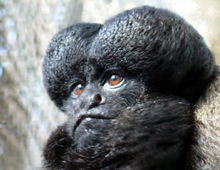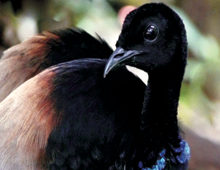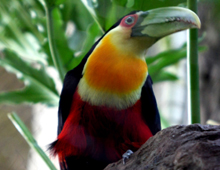Toucan Heights

Red-backed bearded saki, Chiropotes chiropotes
Though it is not at all rare in its native Northeastern South America, this startling-looking monkey has always been very rare in zoos. It had a reputation for being delicate in captivity, but since their arrival in Dallas in 2010, the ones at the DWA have proved robust, and have already produced offspring. They differ from White-faced sakis (whose tails usually hang straight down) by the continuous motion of their remarkably squirrel-like tails.
LEARN MORE
Sunbittern, Eurypyga helias
Another relative of cranes and rails, this Central and South American forest bird is not related to true bitterns, which are herons. When alarmed, it spreads its brilliantly colored wings, completely transforming its appearance. It was first bred in captivity more than 140 years ago, at the London Zoo, and has bred in many places since, including the DWA.
LEARN MORE
Grey-winged trumpeter, Psophia creptitans
Distant relative of cranes, rails, and bustards, trumpeters are found only in the forests of South America. They are named for their complex vocalizations, which sometimes sound if they are producing several sounds at the same time. Though capable of flight, they are usually on the forest floor. Much of the food is fruit that falls out of trees, and they are often beneath troops of monkeys, waiting for the fruit they drop.
LEARN MORE
Red-breasted toucan, Ramphastos dicolorus
Found in Brazil, Paraguay and Argentina, this species remains fairly common despite continuing habitat loss and some hunting pressure (toucans are eaten by people in some places). Though presently rare in collections, it was the first of the Ramphastos toucans bred in captivity, in Germany in 1967. It has also set the age record for any member of its family, one having lived 27 years, and another possibly 32 years. The DWA specimens arrived through the cooperation of the Brazilian Federal wildlife agency, IBAMA.
LEARN MORE

